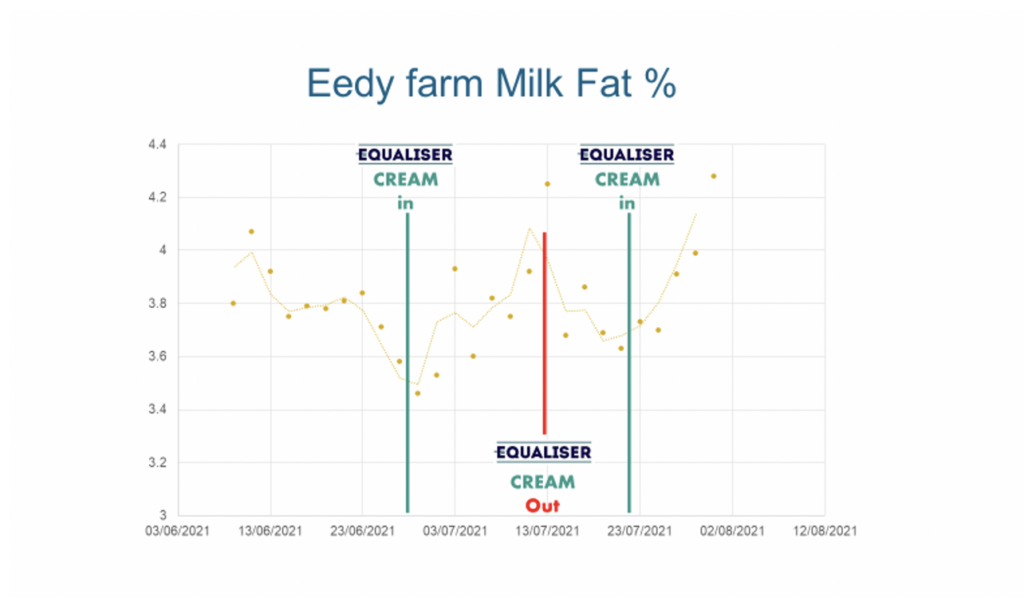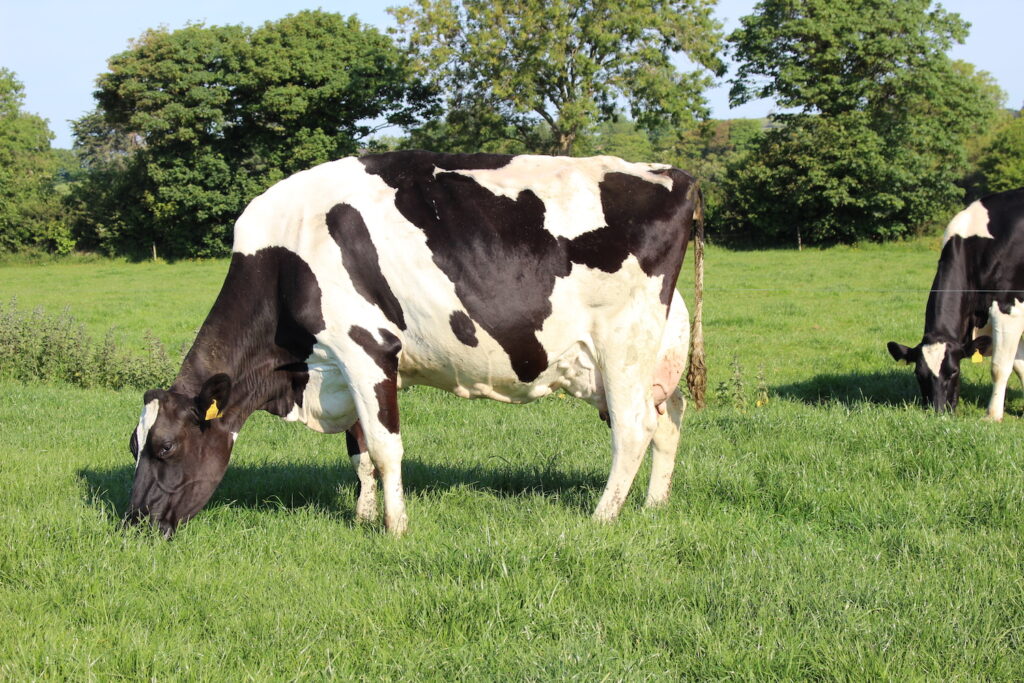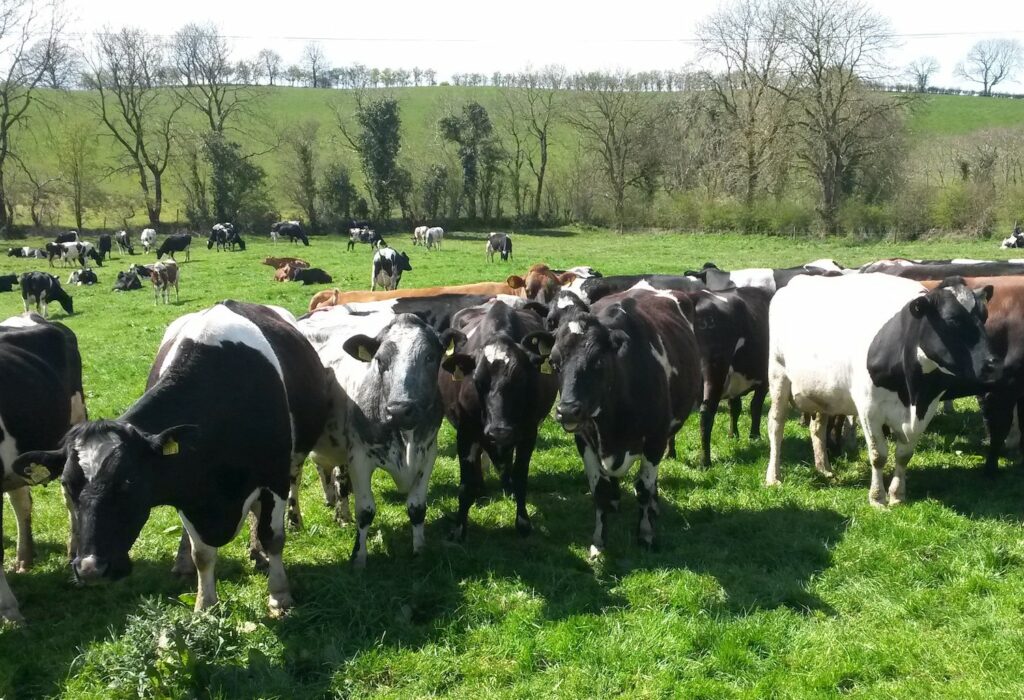Capture the milk fat at turnout
3rd March 2022
The arrival of spring grass and turnout time is welcomed with open arms by many dairy farmers. And nothing beats the sight of cows out grazing. But the downside of turnout can be milk fat depression, particularly in spring and early summer.
Drops of 0.5% in milk fat are typical, and levels can can stay below the herd’s annual average through the summer months.
With most payment schemes based on milk solids, this drop in milk fat represents a significant reduction in milk income, estimated to be worth £4,500 in milk income for a 100-cow herd across 150 days.
Cargill’s specialist rumen buffer Equaliser Cream offers a solution. On farm trial results have shown a rapid and cost-effective reversal of the spring and summer milk fat depression.
Developed by Cargill, this feed product combines unique ingredients, including a proven rumen buffer and a fermentation product, and provides a two-pronged approach.
Cargill’s rumen buffer Equaliser has a buffering capacity more than double that of sodium bicarbonate and it is longer lasting. This helps to maintain rumen pH.
The ‘cream components’, reduce CLA production in the rumen and ‘normalise’ the oil conversion pathways.
So while most nutritional solutions that aim to maintain milk fat just tackle rumen pH, Equaliser Cream has two modes of action that target the causes of milk fat depression and provide a reliable way of improving milk fat.
Results from a grazing herd, where cows experienced a drop of 0.5% in milk fat in spring and where levels stayed at or below 3.5% while at grass and typically failed to recover during the grazing season, the addition of Equaliser Cream reversed the drop very quickly – in a matter of days – and brought levels back up to the 4% level.
This herd also found increased diet digestibility, seen in more consistent manure and an elimination of undigested grains.
Equaliser Cream is a powder available in 25kg bags and can be fed via a TMR or added to blends or compounds. Feed rate is between 100g and 150g/cow/day.
Cargill on-farm trials have shown that Equaliser Cream represents a return on investment of 3:1.
High milk solids derived from an efficient cow are the cornerstone of success for the Helen family’s Eedy herd of pedigree Holsteins in West Cork, Ireland. When milk tank butterfat levels dipped in July 2021, there was cause for quick action, to get cows back on track.
The Helens’ 90-cow herd averages 9,500kg of milk, at 4.1% fat and 3.4% protein and 720kg of solids, with 5,400kg of milk – almost 60% – of yield from forage.
They supply 800,000 litres of milk a year to Lisavaird Co-op for manufacturing, so milk solids are vital.

The Helen family (left to right): Parents Robert and Sylvia, Laura Counthwaite and fiance Jason.
“Feeding is crucial to our success,” says Jason, who runs the herd with his parents Robert and Sylvia on the 57ha unit.
So when butterfats took a dive, there was cause for concern. “Butterfats are always lower when cows are at grass. We target an average of 3.9% in spring through to late summer. But when they dropped to 3.6%, we knew this could have a significant impact on the milk cheque if we didn’t get cows back on track.”
They attributed this dramatic drop in milk fat to the high oil content in the re-growth of lush grass in reseeded pastures after first cut silage.
The Helens added Equaliser Cream to the ration. “It was really like a silver bullet,” adds Jason. “Milk fats jumped back to 3.8% in just a few days – and stabilised.
“We then made a mistake and took it out, thinking the problem was solved, only to see butterfat drop again. So we added it back into the diet, at a rate of 100g/head, and we saw milk fat return to 3.95%. We also removed the straw from the diet”
Milk fat continued to increase and within a week they were above 4.2%, as shown in Figure 1. This was maintained throughout August.

Figure 1: Variation in milk fat production, July 2021.
“During the winter, our butterfat levels average 4.7%. While we wouldn’t expect to average this all year, adding a dedicated cost-effective rumen buffer in the summer months to boost butterfats and reduce the challenges of milk fat depression is progress for us,” says Jason.
The Helens’ feed grass and maize silage, along with bought-in chopped fodder beet, brewers’ grains, urea treated wheat and soya, in winter.
Forages are supplemented with two tonnes of concentrates per cow, which is fed to yield in the parlour.
Cows are turned out during the day from 1st March and re-housed full time by 1st November. Grass-based diets are supplemented with a TMR buffer after evening milking, comprising 10kg of maize silage and 2kg beet pulp, plus chopped straw for added fibre.
“We’ve included a rumen buffer in the TMR all year round to stabilise the diet and maintain rumen health, as the diet, and particularly the forages, change,” adds Jason. “But we’ve reaped the benefits of switching to a specialist buffer that can help us counter dips in butterfat cost-effectively.”

Eady Holsteins.
The combination of the acidic conditions and the high oil content in fresh grass creates a ‘perfect storm’ in the cow’s rumen and disrupts the usual pathways used by the cow to produce milk fat.
A large proportion of dairy herds are affected by milk-fat depression at turnout and through the early grazing season.
“Drops of 0.5% in milk fat are typical, and usually occur during the second and third grazing rotations – between three and nine weeks after turnout,” says Cargill’s ruminant technology manager Philip Ingram. “An average reduction of 0.35% is often seen between April and August.”
He adds that the greatest risk of reduced milk fat is seen where cows are grazing young, green leafy grass. “This grass has lower structural fibre, so digests quicker, as well as higher sugar content, which can create acidic rumen conditions. And it is higher in oil than more mature, later season grass. In spring and early summer, the oil content in grass is 50% richer in unsaturated fats than a typical winter ration.
“Acidic conditions and the high oil content in fresh grass affects the cow’s ability to produce milk fat,” adds Dr Ingram. “Under these conditions, dietary oil is converted to conjugated linoleic acid (CLA). This is an oil that disrupts the fat production pathways and causes a depression in milk fat.”
Equaliser Cream is a specialist rumen buffer designed to target the causes of milk fat depression. “Cream has key ingredients to help reduce the impact of the high oil content of grass on milk fat,” adds Dr Ingram.
“It can promote milk fat production in housed herds too, where highly digestible diets are being fed, or where the silage has a high acid load, or where there is a high level of oil from distilled co-products.”
For more information on Equaliser Cream contact: www.provimi.eu/uk-equaliser or contact your Cargill representative.


